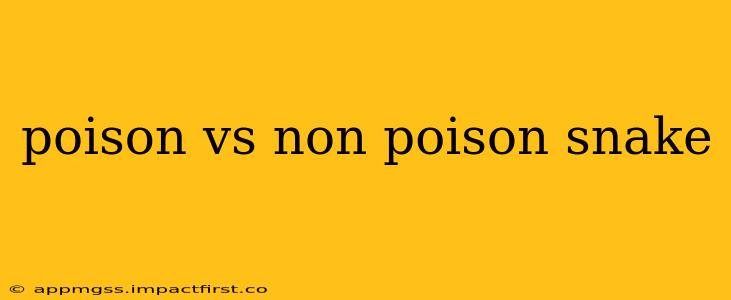Identifying poisonous snakes is crucial for safety, especially in regions where venomous species are prevalent. This guide helps differentiate poisonous (venomous) from non-poisonous snakes, addressing common questions and misconceptions. Understanding the key distinctions can save lives and prevent unnecessary fear.
What Makes a Snake Venomous?
Venomous snakes possess specialized glands that produce venom, a complex mixture of toxins delivered through hollow or grooved fangs. This venom is used primarily to subdue prey, but also serves as a defense mechanism. Non-venomous snakes lack these venom-producing glands and rely on constriction, biting, or other methods to capture and kill their prey.
How to Tell the Difference: Key Physical Characteristics
While there's no single foolproof method, observing several characteristics can significantly improve your ability to distinguish between venomous and non-venomous snakes. Remember, never attempt to handle any wild snake without expert knowledge.
Head Shape
- Venomous: Many venomous snakes possess triangular or heart-shaped heads, due to the presence of large venom glands. However, this is not always reliable, as some non-venomous snakes can also have somewhat triangular heads.
- Non-venomous: Non-venomous snakes typically have more elongated, oval-shaped heads.
Pupil Shape
- Venomous: Many venomous snakes, especially pit vipers, have elliptical or cat-like pupils. However, this is not a universal trait.
- Non-venomous: Round pupils are more common in non-venomous snakes, but again, exceptions exist.
Fangs
- Venomous: Venomous snakes have specialized fangs, either hollow (like those of vipers) or grooved (like those of some elapids). These fangs are used to inject venom.
- Non-venomous: Non-venomous snakes lack fangs specifically designed for venom injection; their teeth are typically small and straight.
Body Shape and Coloration
While body shape and coloration can be helpful indicators, they are highly variable and unreliable for definitive identification. What might be considered typical for one species could vary significantly within the same species or even be mimicked by harmless snakes.
What are the common venomous snakes in my area?
This is a crucial question, and the answer varies greatly depending on your geographic location. To determine the venomous snake species in your area, consult local herpetological societies, wildlife agencies, or universities with herpetology departments. They can provide accurate information and resources specific to your region. Online resources are available, but verify their credibility before relying on them for identification.
How can I avoid snake bites?
Prevention is key when it comes to snakebites. Follow these guidelines:
- Be aware of your surroundings: When hiking or walking in areas where snakes are known to inhabit, pay close attention to your surroundings. Look where you step and place your hands.
- Wear appropriate clothing and footwear: Wear long pants and sturdy boots to protect your skin.
- Avoid reaching into crevices or brush piles: Snakes often seek shelter in these areas.
- Never attempt to handle a snake: Even seemingly harmless snakes can bite out of fear or self-defense.
- Keep pets under control: Dogs and cats are more vulnerable to snakebites.
What should I do if I see a snake?
If you encounter a snake, observe it from a safe distance and give it space. Do not try to approach, capture, or kill it. If it's a venomous species, contact your local wildlife agency or animal control for assistance.
What should I do if I'm bitten by a snake?
A snake bite is a medical emergency. Seek immediate medical attention. If possible, try to note the snake's appearance (without putting yourself in danger) to assist medical professionals in identifying the species and administering the appropriate antivenom. Do not apply a tourniquet or attempt other home remedies; follow the advice of medical personnel.
This information serves as a general guide and should not be substituted for expert identification or medical advice. Always exercise caution around snakes and consult with qualified professionals when dealing with potential venomous encounters. Remember, responsible observation and respect for wildlife are crucial for both human safety and the preservation of snake populations.
